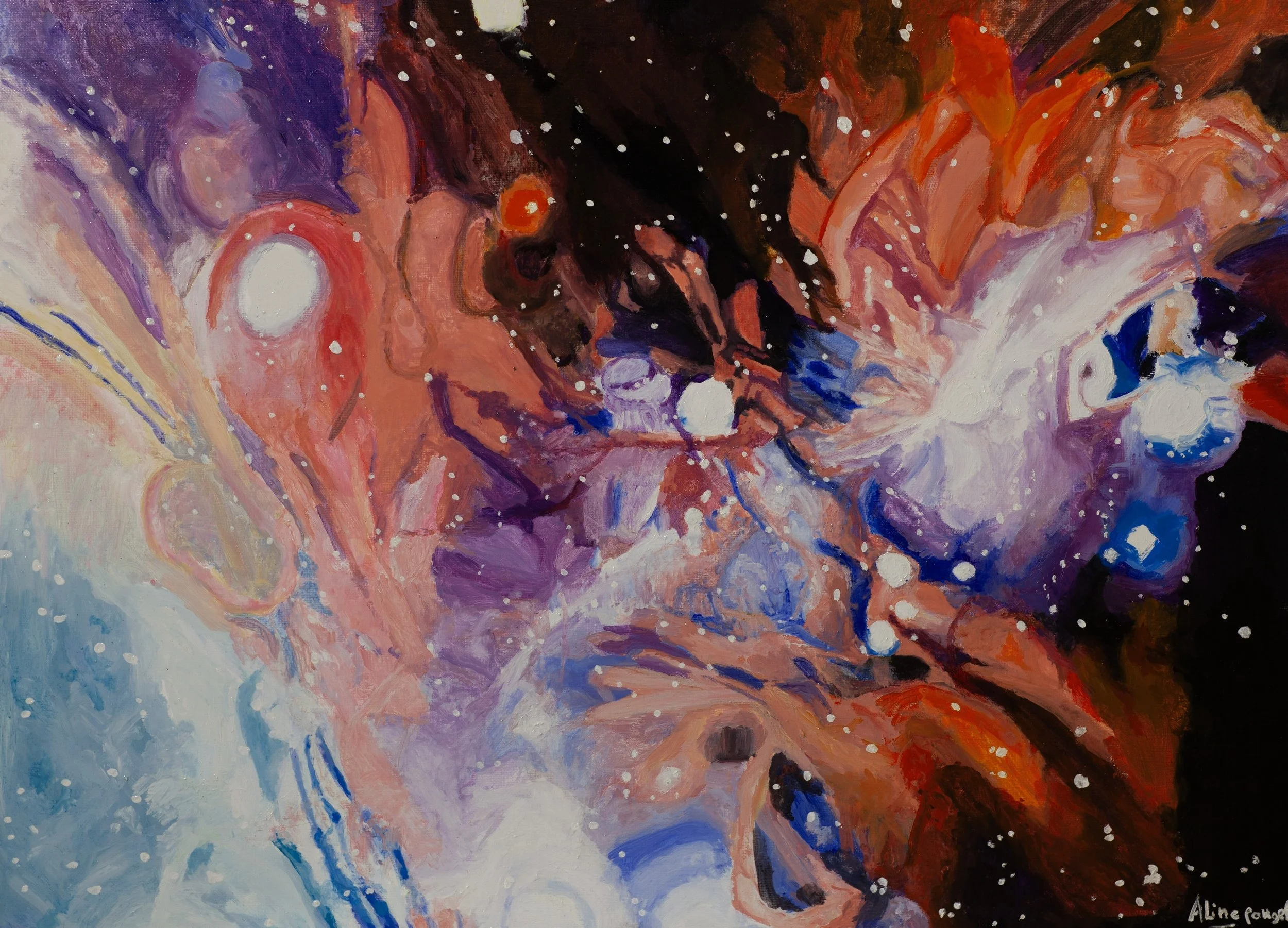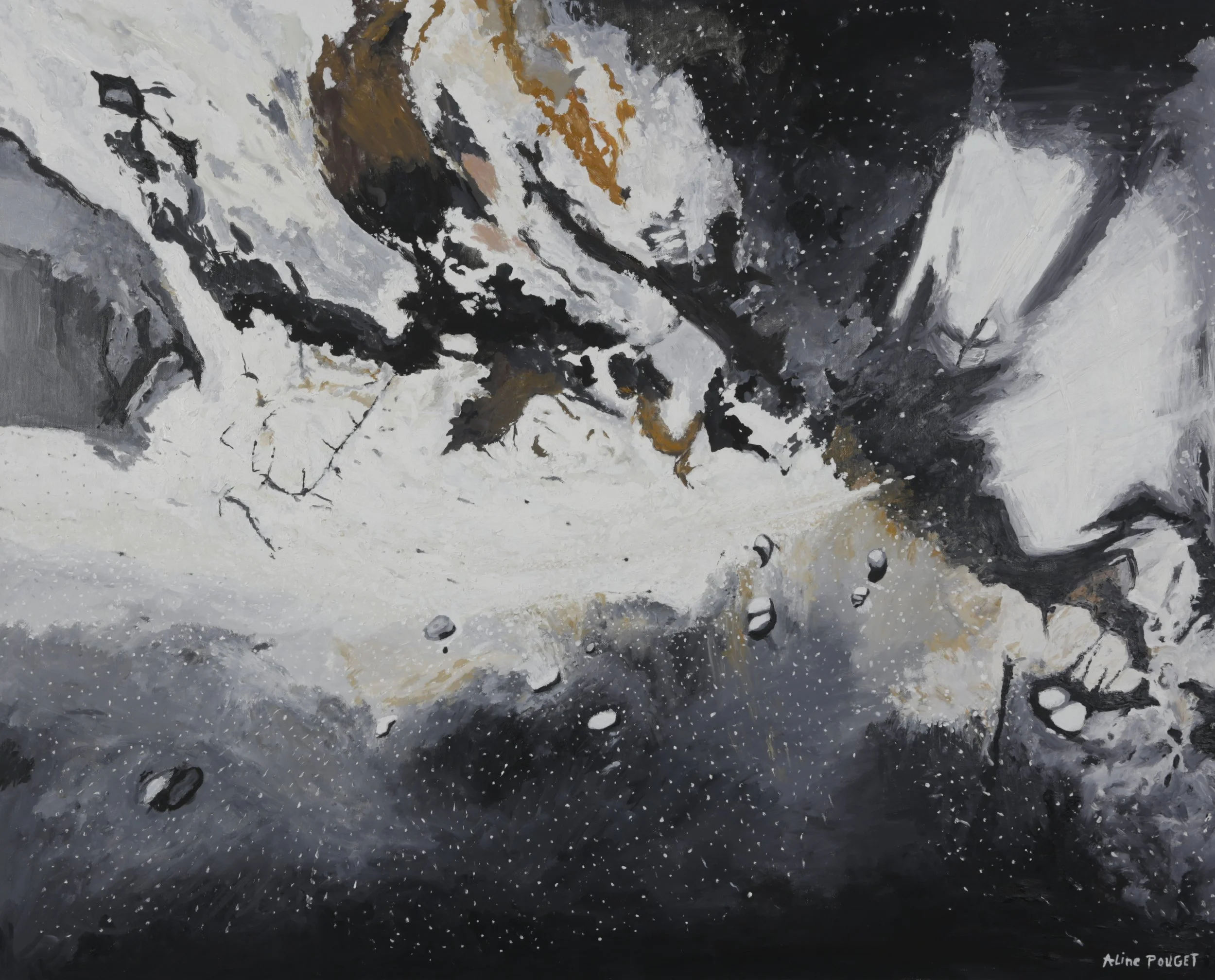Aline Pouget
Aline Pouget is a French contemporary painter who works between Paris and Blois-Chambord.
Having always been drawn to the beauty and colors of nature, her transition to creating art came naturally. She began with watercolor and quickly moved on to oil painting, which gives her greater satisfaction. She paints on canvas or wooden supports.
satisfaction. She paints on canvas or wooden supports. The search for color, light, life, and the beauty of the world around us is the foundation of her art. Her approach allows her to express emotions and feelings that she transposes into her paintings with strength and depth. The intimate meaning of her thoughts, life experiences, and deepest sensations, her sense of the duality between good and evil, shapes her work.
She is inspired by nature, and her masterful paintings form a visual syntax ranging from abstract compositions reflecting an organic universe to expressive portrayals of natural beauty. Revealing and profound, the whirlwind of her compositions highlights her love of nature. Interpretations can vary from palliative and pristine to intensely immersive and profound. Illuminating the very essence of nature and life by juxtaposing them in highly tangible scenes, she bridges the worlds of realism and abstraction. Her paintings capture her visceral response to the universe.
Through a rainbow of colors, the artist employs a palette of varied and monochromatic tones that give each work a vibrant sense of life. This is enhanced by the dynamic style of her compositions and her energetic brushstrokes. A powerful sense of movement and emotion resonates in her work, along with a unique sense of perspective and depth.
Aline Pouget, internationally awarded contemporary painter, has exhibited in remarkable places such as the Vatican Chancellery, the Vicar's Palace in the Vatican during the jubilee year, the Whitney Gallery in New York, the museums of Turin and Barcelona among others.
She has also participated in several major biennials, invited many times to the Florence Biennale, she has also exhibited at the Venice Biennale at the MUSA Pavilion in Palazzo Pisani Revedin in July 2022, at the Rome Triennale. She was invited to the Grand Prix de Rome Capital in December 2021.
Her exhibitions continued at Art Basel 2023 and at Art Capital Paris at the Grand Palais in 2025. It was present at the Japanese digital exhibition site of the company AATANOU throughout 2024. Aline Pouget is featured in the encyclopedia Atlante Contemporary In Arte, one of the only publications archived by the Venice Biennale in 2022. This encyclopedia, which introduced the artist, was republished in 2024 in partnership with the Italian Senate. It was previewed at the Metropolitan Museum in New York and exhibited at Art Basel Miami.
Among the many awards Aline Pouget has received are The Highest Recognition of Arts, Sciences and Culture from the association Italia in Arte, which includes representatives of the Vatican and World Heritage officials, as well as the prestigious Golden Lion of Venice, the Oscars, and the Palmes d'Or. At Aline Pouget's exhibition at the Amsterdam Whitney Gallery in New York, the curators' review committee said: "…Our committee salutes you for your work, with its important visual narrative and its emotional connection to the human and artistic experience. We are amazed by your wonderful artistry and the positive energy of your stellar compositions.
"Kandinsky mused: “To bring the whole into harmony on the canvas is what leads to a work of art.”
Inspired by Kandinsky’s credo, a feeling of harmony and a quest for the beautification of nature are the dominating aesthetic forces of Aline Pouget’s masterful tableaux. Distilled from the soul of nature, her visceral abstract works infuse their space with a fulcrum of expressive sensations, resonating with the emotional essence of the natural world. An appreciation for the wonder of nature fills her art with an aesthetic of harmonious vitality, as her organically atmospheric paintings come alive with an energetic tranquility. Creating her compositions in oil paint on canvas, she allows her tableaux a balanced space to develop their full impact….”
The work and vision of Aline Pouget, born from the observation of nature, color, light, and movement, allow her to translate and express her emotions and thoughts, and to share them with the world through her paintings.
Aline Pouget says: "My happiness and my accomplishment are to share my passion, my love of life, the universe, the colours, the light and my multiple emotions through my work."
Aline, your works traverse the liminal space between abstraction and figuration, often suspending the viewer between the tangible and the transcendent. How do you negotiate this threshold in your process, and to what extent is ambiguity a deliberate tool in your visual language?
The threshold noticed is instinctive for me, but the illusion and the real consciousness of life are tangible and a reality for many.
Color appears to be both subject and structure in your practice—an emotional force and a compositional compass. Can you speak to your chromatic philosophy? Are your palettes intuitive outpourings or rigorously premeditated sequences?
My passion for colors is really very important and it is an intrinsic value for me. My palettes are really intuitive and unconscious outpourings. Colour reveals itself to me naturally and strongly.
You’ve been recognized with prestigious awards from the Golden Lion in Venice to the Palme d’Or in Monaco, yet your work maintains an intimate vulnerability. How do you navigate the interplay between public recognition and the personal, often spiritual, solitude of creation?
I have a lot of hindsight and lucidity about all these incredible recognitions that really honor me. I realize this public international recognition but when I create, concentrated alone in front of my canvas, I am completely captivated and collected by my work and nothing distracts me around me.
You’ve exhibited in cities historically rich in both classical and avant-garde traditions: Florence, Rome, New York, Vienna. How do the cultural energies of these cities infiltrate your practice, and do they leave specific imprints on your canvases?
The sight of these wonderful creations, whether they are from the Renaissance as in Florence or some avant-garde in New York, captivates and enthuses me. All this creative energy inspires me and some creations, more particular, whether they are Renaissance or more modern, touch me more deeply and guide me on my canvases.
Your paintings often seem like orchestrations of motion and stillness, where gestural liberation coexists with structured restraint. Is there a philosophical or emotional duality, perhaps even a moral one, you’re expressing through this contrast?
My work is based on the manifestation of my intimate sensations and thoughts. My works translate my emotions that are released on my canvases intuitively. Life is in perpetual motion, but it takes moments of stillness to notice its beauty and reflect on one's own destiny.
You’ve spoken of expressing the ‘duality between good and evil’ in your work. In an age of moral relativism and cultural fragmentation, how do you visually articulate this ethical tension without reducing it to illustration?
My work "Infinite" really symbolizes this duality. And the work "Peace and Universal Conscience" is an apology for the fact that human beings are all connected and that they must transcend themselves for the better, beauty and wisdom.
Nature, the city, and the cosmos coalesce in your compositions, forming a kind of visual ecology. Do you see your canvases as symbolic microcosms, porous environments where organic and constructed worlds attempt to reconcile?
Indeed, for me, nature, the city and the cosmos are intimately linked. These three entities represent a whole that symbolizes a path, a direction. They are sets that complement each other and have a common dimensional and transcendent meaning.
As a woman artist celebrated internationally and featured in events like the UNESCO Woman’s Essence Show, how do you reflect on the evolving role of femininity and emotional transparency in abstract painting today?
The emotions, the sensations of the soul are, for me, unisex, as well as talent. Personally, men and women are complementary and equal. In today's abstract painting, the artistic talents of these two entities are identical and complementary.
Your work has been included in publications like Atlante dell’Arte Contemporanea, which was selected for the Historical Fund of the Venice Biennale. In your view, what is the responsibility of contemporary art in contributing to a historical continuum, especially amid global instability?
Art history is the backbone of human consciousness, beauty, and the soul. It must be the vector of the memory of the art of our time and a guide for humanity.
You’ve described your art as a transposition of intimate emotions shaped by life’s events. How has your understanding of catharsis evolved over the years—has painting become more of a release, a revelation, or a reckoning?
All this at the same time. I reveal my subjective and intimate vision, my awareness of the complexity of life, art, science and culture. My works are the transposed result of my awareness of the complex states of life. I release on my canvases all my intertwined and revealed states of mind.










